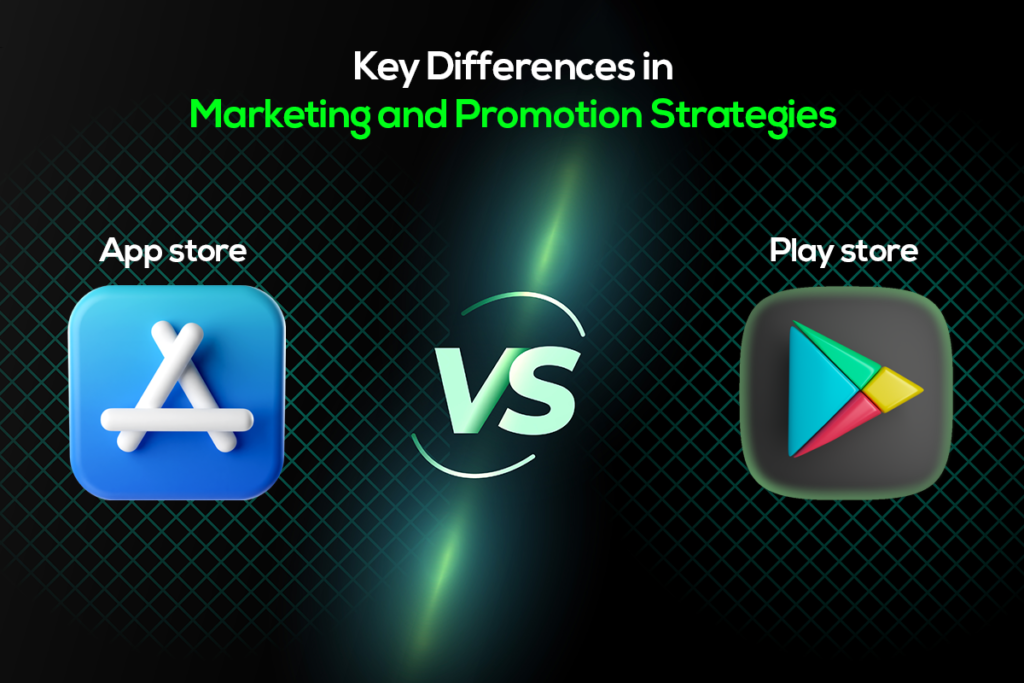
App Store vs. Google Play Store: Key Differences in Marketing and Promotion Strategies
Introduction
Navigating the intricacies of app marketing can be challenging, especially when it comes to two of the largest app marketplaces – the App Store and Google Play Store. In this article, we’ll explore the essential differences in marketing and promotion strategies for these platforms, equipping app developers and business owners with insights to maximize their app’s visibility and success.
Understanding the App Store Ecosystem
Apple’s Stringent App Review Process
Comprehending Apple’s meticulous app review process is crucial for app developers aiming to launch on the App Store.
This process ensures that apps meet strict guidelines, enhancing the overall user experience and maintaining Apple’s reputation for quality and security. Every detail matters, from design and functionality to content and privacy measures.
This review process begins with a thorough examination of your app’s functionality, ensuring it performs as expected and provides value to users. Apple also evaluates the app’s design, considering factors such as user interface consistency, intuitiveness, and adherence to Apple’s design principles. Additionally, the review covers aspects related to user data privacy and security, emphasizing the protection of user information.
Fulfilling Apple’s guidelines is a prerequisite for app approval. Common reasons for app rejections include bugs, crashes, inappropriate content, or incomplete information. It’s essential to review Apple’s App Store Review Guidelines carefully and test your app thoroughly before submission.
While this stringent process might seem challenging, it ensures a higher level of quality and trust among users. As an app developer or business owner, adhering to Apple’s guidelines not only facilitates a smoother app launch but also demonstrates a commitment to providing a top-notch user experience.
The Power of App Store Optimization (ASO)
App Store Optimization (ASO) is the backbone of a successful app’s visibility on the App Store. This strategy involves various techniques aimed at improving your app’s discoverability within the store, ultimately leading to increased downloads and user engagement.
One of the fundamental aspects of ASO is keyword optimization. Carefully selecting relevant keywords for your app’s title and description can significantly impact its search ranking. It’s crucial to research and choose keywords that accurately represent your app’s core features and target audience.
Ratings and user reviews also play a pivotal role in ASO. Apps with higher ratings and positive reviews are more likely to attract users. Encourage satisfied users to leave reviews, and promptly address any negative feedback to maintain a positive overall rating.
Regularly updating your app with bug fixes, new features, and enhancements is essential not only for user satisfaction but also for ASO. Frequent updates show that your app is actively maintained, which can positively influence its ranking.
App icons, screenshots, and preview videos contribute to the visual appeal of your app’s store page. These elements should be visually engaging and accurately represent your app’s functionality.
It’s essential to monitor your app’s performance and the impact of your ASO efforts. Analyze key metrics such as app store impressions, conversion rates, and user retention to refine your ASO strategy continually.
By understanding and implementing effective ASO techniques, you can significantly boost your app’s visibility on the App Store, attracting more organic traffic and increasing the likelihood of user downloads.
Navigating the Google Play Store Landscape
Android’s Open Ecosystem
One of the key differentiators of the Google Play Store is its open ecosystem. Unlike the more controlled environment of the App Store, the Play Store welcomes a wide variety of Android devices from various manufacturers. This inclusivity provides both opportunities and challenges for app developers and business owners.
The diverse range of Android devices means that your app needs to be adaptable to different screen sizes, resolutions, and hardware capabilities. Ensuring compatibility across this spectrum of devices can be complex, but it’s essential to maximize your app’s reach.
Moreover, the open nature of the Play Store means that there’s more flexibility in app distribution. You can choose to distribute your app through alternative app stores or directly from your website, giving you more control over how users access your app.
While this open ecosystem is advantageous in terms of reaching a broad audience, it also poses challenges in terms of fragmentation. It’s crucial to thoroughly test your app on various devices and Android versions to ensure consistent performance and user experience.
Understanding and leveraging the benefits of Android’s open ecosystem while effectively managing the challenges can lead to significant success on the Google Play Store.
Leveraging User Engagement
Engaging users is a crucial factor for app success on the Google Play Store. Android users tend to have a diverse set of preferences, and a high-quality app that addresses their needs can lead to strong user retention.
One of the ways to boost user engagement is by consistently delivering value through updates and new features. Listen to user feedback and prioritize enhancements that align with their expectations.
Personalization is another powerful tool for user engagement. Tailor your app’s experience to match individual user preferences and behaviors. This can range from customized content recommendations to personalized notifications.
In-app communication is essential. Keep users informed about updates, promotions, and relevant content without being intrusive. Finding the right balance between engagement and respect for user privacy is key.
Remember that user reviews and ratings matter on the Play Store as well. Encourage users to leave positive reviews, and respond constructively to negative feedback to show your commitment to improving the app.
By focusing on user engagement and delivering value consistently, you can create a loyal user base and drive the success of your app on the Google Play Store.
Tailoring Marketing Strategies
App Store’s Premium Audience
Understanding the demographics of iOS users is essential for effective marketing on the App Store. iOS users often have higher disposable income, making them a valuable target audience for certain types of apps, particularly those with premium pricing or in-app purchases.
Tailor your marketing efforts to appeal to this premium audience. Highlight the unique features and benefits of your app that resonate with users seeking high-quality experiences. Emphasize aspects like design, user experience, and exclusivity.
Leverage the strong brand association that comes with the Apple ecosystem. Many iOS users are loyal to the brand and trust Apple’s commitment to quality and security. Position your app as a top-tier offering within this trusted environment.
Localization is also crucial. If your app is available in multiple languages, ensure that your marketing materials, including the App Store listing, are localized to resonate with users from different regions. This demonstrates a commitment to catering to diverse audiences.
By tailoring your marketing strategies to the premium audience of the App Store, you can increase your app’s visibility among users who are more inclined to invest in high-quality apps, ultimately boosting your app’s success.
Google Play’s Wide Reach
The Google Play Store offers an extensive user base with a wide range of preferences and interests. This diversity presents a unique opportunity for reaching a broad audience with your app. However, it also requires a strategic approach to stand out effectively.
Analyze the demographics of Android users to understand their preferences. Android users often appreciate customization and versatility. Highlight how your app aligns with these values to appeal to this diverse audience.
Localization is equally vital on the Play Store. Tailor your app’s messaging and content to resonate with users from different cultural backgrounds. Ensure that your app’s store listing is localized, including the app description and screenshots.
Take advantage of the Google Play Store’s global reach to expand your app’s visibility in multiple markets. Consider offering your app in regions where there is high demand and competition is relatively low.
Remember that pricing can play a role. Offering a free version of your app with in-app purchases or a freemium model can attract a broader user base, while offering a paid version with additional features can appeal to users looking for premium experiences.
By understanding the wide-reaching nature of the Google Play Store, you can create a marketing strategy that appeals to diverse users and maximizes your app’s potential for success.
Promotional Techniques
App Store Exclusive Features
The App Store offers unique features that can enhance your app’s visibility and revenue. Two notable examples are Apple Search Ads and in-app purchases. Leveraging these features effectively can give your app a competitive edge.
- Apple Search Ads: This advertising platform allows you to promote your app at the top of search results in the App Store. By targeting relevant keywords, you can increase your app’s visibility to users actively searching for apps in your niche. It’s a powerful way to drive targeted traffic and increase downloads.
- In-App Purchases: Offering in-app purchases allows you to generate revenue directly from users who find value in your app. This feature is particularly effective for freemium apps, where users can access the basic version for free and then opt to purchase additional features or content within the app.
Highlight the benefits of these exclusive App Store features in your marketing efforts. Showcase how they enhance the user experience, and emphasize the value users will receive by choosing your app.
Google Play Store Promotions
The Google Play Store also provides promotional opportunities to increase your app’s visibility.
- Pre-Registration: If you’re launching a new app or a significant update, consider offering pre-registration. This allows users to express interest in your app before it’s officially available, generating anticipation and buzz.
- Early Access: Early access programs allow a select group of users to try your app before the official release. This strategy can help generate positive reviews, identify potential issuesMarketing and Promotion Strategies, and build excitement.
Additionally, consider offering limited-time discounts or special promotions to encourage users to download and engage with your app.
By utilizing these promotional techniques, both exclusive to the App Store and available on the Google Play Store, you can significantly enhance your app’s visibility, attract more users, and drive app success.
Conclusion
In this article, we’ve delved into the key differences in marketing and promotion strategies between the App Store and Google Play Store. By understanding the unique characteristics of each platform, you can tailor your approach to reach the right audience and maximize your app’s success.
Empower yourself as an app developer or business owner with actionable insights from this article. Remember the importance of adhering to Apple’s stringent review process and the power of App Store Optimization (ASO) for the App Store. For the Google Play Store, leverage the open ecosystem, engage users effectively, and consider the broad user base’s preferences.
By implementing these strategies, exploring exclusive features, and utilizing promotional opportunities, you’re well-equipped to navigate the complexities of app marketing and drive your app towards achieving its full potential.
Please feel free to Contact Us in case you need any guidance regarding your app marketing needs.




0